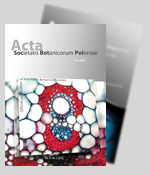Evolutionary Pattern of High Variation Traits in Subfamily Zygophylloideae (Zygophyllaceae)
Abstract
Keywords
References
Agrawal, A. A., Salminen, J.-P., & Fishbein, M. (2009). Phylogenetic trends in phenolic metabolism of milkweeds (Asclepias): Evidence for escalation. Evolution, 63(3), 663–673. https://doi.org/10.1111/j.1558-5646.2008.00573.x
Ahrens, D., Fujisawa, T., Krammer, H.-J., Eberle, J., Fabrizi, S., & Vogler, A. P. (2016). Rarity and incomplete sampling in DNA-based species delimitation. Systematic Biology, 65(3), 478–494. https://doi.org/10.1093/sysbio/syw002
Arbuckle, K., & Minter, A. (2015). Windex: Analyzing convergent evolution using the Wheatsheaf index in R. Evolutionary Bioinformatics, 11, 11–14. https://doi.org/10.4137/ebo.s20968
Beier, B. A. (2005). A revision of the desert shrub Fagonia (Zygophyllaceae). Systematics and Biodiversity, 3(3), 221–263. https://doi.org/10.1017/S1477200005001684
Beier, B. A., Chase, M. W., & Thulin, M. (2003). Phylogenetic relationships and taxonomy of subfamily Zygophylloideae (Zygophyllaceae) based on molecular and morphological data. Plant Systematics and Evolution, 240(1–4), 11–39. https://doi.org/10.1007/s00606-003-0007-0
Berenbaum, M. R., Favret, C., & Schuler, M. A. (1996). On defining “key innovations” in an adaptive radiation: Cytochrome P450s and papilionidae. The American Naturalist, 148, S139–S155. https://doi.org/10.1086/285907
Brunet, J., & Larson-Rabin, Z. (2012). The response of flowering time to global warming in a high-altitude plant: The impact of genetics and the environment. Botany, 90(4), 319–326. https://doi.org/10.1139/b2012-001
Buckley, L. B., Nufio, C. R., & Kingsolver, J. G. (2014). Phenotypic clines, energy balances and ecological responses to climate change. Journal of Animal Ecology, 83(1), 41–50. https://doi.org/10.1111/1365-2656.12083
Chevin, L.-M., Lande, R., & Mace, G. M. (2010). Adaptation, Plasticity, and Extinction in a Changing Environment: Towards a Predictive Theory. PLoS Biology, 8(4), e1000357–e1000357. https://doi.org/10.1371/journal.pbio.1000357
Darriba, D., Taboada, G. L., Doallo, R., & Posada, D. (2012). jModelTest 2: More models, new heuristics and parallel computing. Nature Methods, 9(8), 772–772. https://doi.org/10.1038/nmeth.2109
Feder, J. L., Egan, S. P., & Forbes, A. A. (2012). Ecological adaptation and speciation: The evolutionary significance of habitat avoidance as a postzygotic reproductive barrier to gene flow. International Journal of Ecology, 2012, Article 456374. https://doi.org/10.1155/2012/456374
Grinnell, J. (1917). The niche-relationships of the California thrasher. The Auk, 34(4), 427–433. https://doi.org/10.2307/4072271
Holt, R. D. (2009). Bringing the Hutchinsonian niche into the 21st century: Ecological and evolutionary perspectives. Proceedings of the National Academy of Sciences of the United States of America, 106(Suppl. 2), 19659–19665. https://doi.org/10.1073/pnas.0905137106
Hunter, J. P., & Jernvall, J. (1995). The hypocone as a key innovation in mammalian evolution. Proceedings of the National Academy of Sciences of the United States of America, 92(23), 10718–10722. https://doi.org/10.1073/pnas.92.23.10718
Jablonski, D. (2008). Species selection: Theory and data. Annual Review of Ecology, Evolution, and Systematics, 39, 501–524. https://doi.org/10.1146/annurev.ecolsys.39.110707.173510
Jump, A. S., & Penuelas, J. (2005). Running to stand still: Adaptation and the response of plants to rapid climate change. Ecology Letters, 8(9), 1010–1020. https://doi.org/10.1111/j.1461-0248.2005.00796.x
Kembel, S. W., Cowan, P. D., Helmus, M. R., Cornwell, W. K., Morlon, H., Ackerly, D. D., Blomberg, S. P., & Webb, C. O. (2010). Picante: R tools for integrating phylogenies and ecology. Bioinformatics, 26(11), 1463–1464. https://doi.org/10.1093/bioinformatics/btq166
Kocher, T. D. (2004). Adaptive evolution and explosive speciation: The cichlid fish model. Nature Reviews Genetics, 5(4), 288–298. https://doi.org/10.1038/nrg1316
Kumar, S., Stecher, G., Li, M., Knyaz, C., & Tamura, K. (2018). MEGA X: Molecular Evolutionary Genetics Analysis across computing platforms. Molecular Biology and Evolution, 35(6), 1547–1549. https://doi.org/10.1093/molbev/msy096
Laughlin, D. C. (2014). The intrinsic dimensionality of plant traits and its relevance to community assembly. Journal of Ecology, 102(1), 186–193. https://doi.org/10.1111/1365-2745.12187
Lauterbach, M., de Wet van der Merwe, P., Keßler, L., Pirie, M. D., Bellstedt, D. U., & Kadereit, G. (2016). Evolution of leaf anatomy in arid environments – a case study in southern African Tetraena and Roepera (Zygophyllaceae). Molecular Phylogenetics and Evolution, 97, 129–144. https://doi.org/10.1016/j.ympev.2016.01.002
Matsuzaki, S. S., Sasaki, T., & Akasaka, M. (2016). Invasion of exotic piscivores causes losses of functional diversity and functionally unique species in Japanese lakes. Freshwater Biology, 61(7), 1128–1142. https://doi.org/10.1111/fwb.12774
Mcghee, G. R. (2011). Convergent evolution: Limited forms most beautiful. MIT Press. https://doi.org/10.7551/mitpress/9780262016421.001.0001
Merilä, J., & Hendry, A. P. (2014). Climate change, adaptation, and phenotypic plasticity: The problem and the evidence. Evolutionary Applications, 7(1), 1–14. https://doi.org/10.1111/eva.12137
Ning, T., Xiao, H., Li, J., Hua, S., & Zhang, Y. P. (2010). Adaptive evolution of the mitochondrial ND6 gene in the domestic horse. Genetics and Molecular Research, 9(1), 144–150. https://doi.org/10.4238/vol9-1gmr705
Orme, D., Freckleton, R., Thomas, G., Petzoldt, T., Fritz, S., Isaac, N., & Pearse, W. (2012). Caper: Comparative analyses of phylogenetics and evolution in R. R package version 0.5. Retrieved from https://cran.r-project.org/web/packages/caper/index.html
Penney, H. D., Hassall, C., Skevington, J. H., Abbott, K. R., & Sherratt, T. N. (2012). A comparative analysis of the evolution of imperfect mimicry. Nature, 483(7390), 461–464. https://doi.org/10.1038/nature10961
Pinheiro, J., Bates, D., Debroy, S., Sarkar, D., & Team, R. C. (2013). nlme: Linear and nonlinear mixed effects models. R package version 31–131. Retrieved from https://cran.r-project.org/web/packages/nlme/index.html
Rambaut, A., Suchard, M., & Drummond, A. (2014). Tracer v1.6. Retrieved from https://beast.bio.ed.ac.uk/Tracer
Ree, R. H. (2005). Detecting the historical signature of key innovations using stochastic models of character evolution and cladogenesis. Evolution, 59(2), 257–265. https://doi.org/10.1554/04-369
Reich, P. B., Wright, I. J., Cavender-Bares, J., Craine, J. M., Oleksyn, J., Westoby, M., & Walters, M. B. (2003). The evolution of plant functional variation: Traits, spectra, and strategies. International Journal of Plant Sciences, 164(S3), S143–S164. https://doi.org/10.1086/374368
Ronquist, F., Teslenko, M., van der Mark, P., Ayres, D. L., Darling, A., Höhna, S., Larget, B., Liu, L., Suchard, M. A., & Huelsenbeck, J. P. (2012). MrBayes 3.2: Efficient Bayesian phylogenetic inference and model choice across a large model space. Systematic Biology, 61(3), 539–542. https://doi.org/10.1093/sysbio/sys029
Segar, S. T., Pereira, R. A. S., Compton, S. G., & Cook, J. M. (2013). Convergent structure of multitrophic communities over three continents. Ecology Letters, 16(12), 1436–1445. https://doi.org/10.1111/ele.12183
Sheahan, M. C. (2007). Zygophyllaceae. In K. Kubitzki (Ed.), Flowering plants. Eudicots (pp. 488–500). Springer. https://doi.org/10.1007/978-3-540-32219-1_56
Sheahan, M. C., & Chase, M. W. (2000). Phylogenetic relationships within Zygophyllaceae based on DNA sequences of three plastid regions, with special emphasis on Zygophylloideae. Systematic Botany, 25(2), 371–371. https://doi.org/10.2307/2666648
Tingley, M. W., Monahan, W. B., Beissinger, S. R., & Moritz, C. (2009). Birds track their Grinnellian niche through a century of climate change. Proceedings of the National Academy of Sciences of the United States of America, 106(Supplement_2), 19637–19643. https://doi.org/10.1073/pnas.0901562106
Vincenzi, S. (2014). Extinction risk and eco-evolutionary dynamics in a variable environment with increasing frequency of extreme events. Journal of The Royal Society Interface, 11(97), Article 20140441. https://doi.org/10.1098/rsif.2014.0441
Walsh, J., Shriver, W. G., Olsen, B. J., & Kovach, A. I. (2016). Differential introgression and the maintenance of species boundaries in an advanced generation avian hybrid zone. BMC Evolutionary Biology, 16(1), Article 65. https://doi.org/10.1186/s12862-016-0635-y
Wheat, C. W., Vogel, H., Wittstock, U., Braby, M. F., Underwood, D., & Mitchell-Olds, T. (2007). The genetic basis of a plant insect coevolutionary key innovation. Proceedings of the National Academy of Sciences of the United States of America, 104(51), 20427–20431. https://doi.org/10.1073/pnas.0706229104
Whittall, J. B., & Hodges, S. A. (2007). Pollinator shifts drive increasingly long nectar spurs in columbine flowers. Nature, 447(7145), 706–709. https://doi.org/10.1038/nature05857
Wilson, A. J. (2013). Flora of Australia. Meliaceae, Rutaceae, Zygophyllaceae (Vol. 26). CSIRO Publishing.
Winemiller, K. O., Fitzgerald, D. B., Bower, L. M., & Pianka, E. R. (2015). Functional traits, convergent evolution, and periodic tables of niches. Ecology Letters, 18(8), 737–751. https://doi.org/10.1111/ele.12462
Wu, S. D., Zhang, L. J., Lin, L., Yu, S. X., Chen, Z. D., & Wang, W. (2018). Insights into the historical assembly of global dryland floras: The diversification of Zygophyllaceae. BMC Evolutionary Biology, 18(1), Article 166. https://doi.org/10.1186/s12862-018-1277-z
Wu, Z., Raven, P., & Hong, D. (2008). Flora of China (Vol. 11). Science Press.
DOI: https://doi.org/10.5586/asbp.8911
|
|
|








